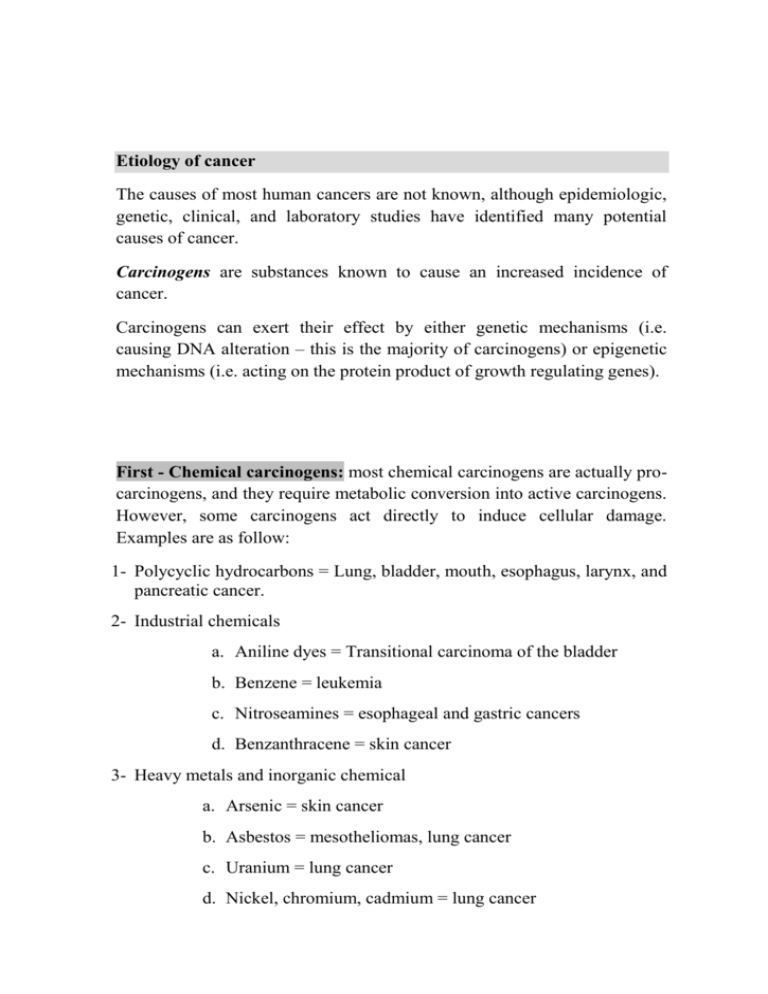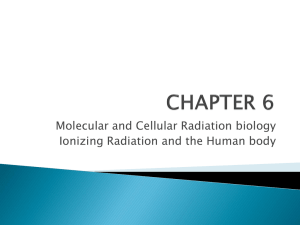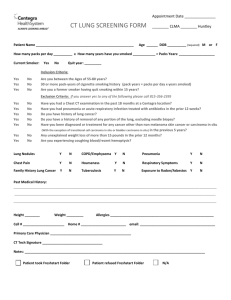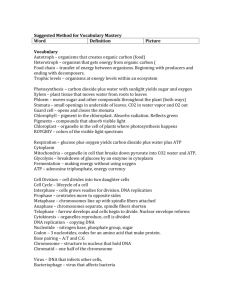Etiology of cancer, carcinogens
advertisement

Etiology of cancer The causes of most human cancers are not known, although epidemiologic, genetic, clinical, and laboratory studies have identified many potential causes of cancer. Carcinogens are substances known to cause an increased incidence of cancer. Carcinogens can exert their effect by either genetic mechanisms (i.e. causing DNA alteration – this is the majority of carcinogens) or epigenetic mechanisms (i.e. acting on the protein product of growth regulating genes). First - Chemical carcinogens: most chemical carcinogens are actually procarcinogens, and they require metabolic conversion into active carcinogens. However, some carcinogens act directly to induce cellular damage. Examples are as follow: 1- Polycyclic hydrocarbons = Lung, bladder, mouth, esophagus, larynx, and pancreatic cancer. 2- Industrial chemicals a. Aniline dyes = Transitional carcinoma of the bladder b. Benzene = leukemia c. Nitroseamines = esophageal and gastric cancers d. Benzanthracene = skin cancer 3- Heavy metals and inorganic chemical a. Arsenic = skin cancer b. Asbestos = mesotheliomas, lung cancer c. Uranium = lung cancer d. Nickel, chromium, cadmium = lung cancer 4- Drugs a. Diethylstilbesterol =vaginal clear cell carcinoma b. Alkylating agents = leukemia, lymphoma c. Cyclophosphamide = bladder cancer 5- Natural plant products a. Aflatoxin B = hepatic cancer b. Betel nut = mouth cancer Stages of chemical carcinogenesis: 1- Initiation – induction of a genetic alteration in oncogene or tumor suppressor gene. 2- Promotion – a stimulus for proliferation of initiated cells; this may be an external agent or a further random mutational genetic abnormality. 3- Persistence – stage where proliferation of tumor cells become autonomous, i.e. it no longer require the presence of initiators or promoters. Second – Radiation: Radiation can be ionizing (natural, therapeutic, and nuclear radiation), or non-ionizing (UV radiation). Radiation can result in DNA damage in two ways: Directly – causing strand break, base alterations, and cross linking. Indirectly – ionization of H2O with formation of reactive oxygen free radicals, which interact with and damage DNA. UV radiation: is associated with squamous cell carcinoma, basal cell carcinoma, and malignant melanoma. X-ray radiation: radiotherapy can cause cancer as well as curing it. It is associated with radiation-induced malignant neoplasms, usually sarcomas. These tumors occur months or years after radiation therapy, e.g. in the lungs, CNS, bone, kidneys, and liver. Radioisotopes: radioactive iodine, used to treat thyroid disease, is associated with increased risk of cancer 15-25 years post treatment. Nuclear radiation: survivors of Hiroshima and Nagasaki atomic bambs, and of the Chernobyl nuclear power plant accident, have a greatly increased incidence of cancer including leukemia and carcinoma of breast, lung, and thyroid. Third – Viruses: Certain DNA viruses and retroviruses can cause neoplasia, as follow: DNA viruses insert DNA directly into the host genome. Retroviruses have reverse transcriptase enzyme to produce a DNA copy of viral RNA. The DNA copy is then inserted into the host genome. Examples of oncogenic viruses Type Virus Tumor type Retrovirus Human T cell leukemia virus T cell leukemia HTLV Human immunodeficiency virus AIDS-related lymphomas HIV DNA virus Human Papillomavirus Skin Papilloma (common wart), cervical carcinoma Epstein-Barr virus Carcinoma of nasopharynx, Burkitt's lymphoma Hepatitis B virus Hepatocellular carcinoma







